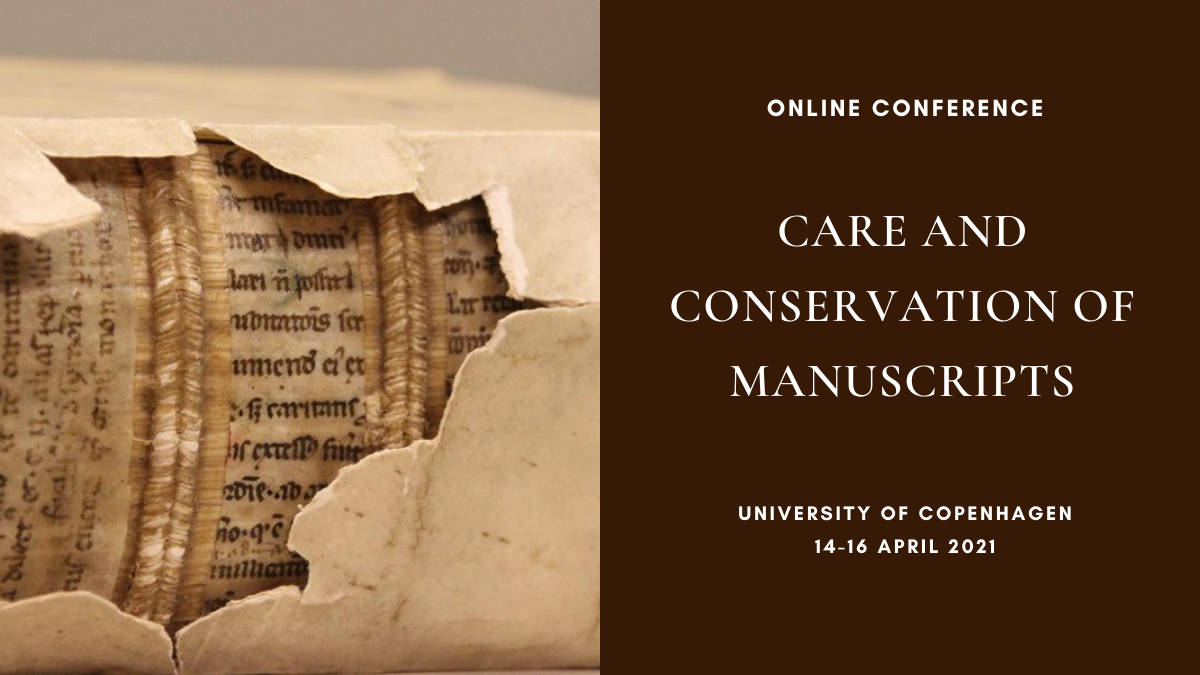
In April, the book team at State Library Victoria tuned into the Care and Conservation of Manuscripts 18 conference held online by the University of Copenhagen. The seminar presented a range of topics by many international speakers who showcased their work with early printed book and manuscript collections from around the world.
Highlights for our team included Andrew Honey’s presentation on the work of bookbinder Beatrice Forder and her rebinding of the Winchester Bible in 1947–48. In 2014, conservators from the Bodleian Library began conservation treatment of the bible. Honey presents an analysis of Forder’s work, which was studied prior to and during the recent rebinding. Honey makes connections to the texts that Forder likely referred to during her work and to the prominent male binders of the time, Douglas Cockerell and Roger Powell. Although influenced by these texts and binders, Honey finds that Forder brings her own style and approach to her work. Her treatment of the bible shows careful consideration, resulting in a less interventive and therefore more reversible treatment, which was pioneering for the time. Honey’s study and consideration for his predecessors, especially Forder’s work, seems key to his own practice and creates a thought-provoking presentation of understanding historical manuscript conservation and how it hinders and helps our practice today.
We enjoyed Katherine Beaty and Kelli Piotrowski’s presentation on the survey and treatment of a collection of Italian stationary bindings from Harvard University. This was a large and collaborative project that offered insight into both the style and condition issues associated with these bindings. The authors presented an overview of their collection survey methodology and the types of information they collected such as binding structure, materials used and condition. The survey data was collated using Google Forms, which was easily uploaded to Harvard’s internal conservation database. The authors also presented an overview of the common damages evident in the collection and their approach to treatment. Great examples shown were the treatment of a variety of loose and broken vellum lacings, repair of fractured iron-gall ink spine labels, toning of parchment for large fills, and loss compensation for pulp boards. A good balance of minimal intervention stabilisation techniques was also discussed; many concave spines were not interfered with, distorted thongs were not reshaped, loose lacing was merely stabilised in place and bindings with missing sections were padded out with removable support.
It was fascinating to hear about the investigation and analysis of 12th and 13th century Romanesque bindings from the Abbey of Clairvaux in France, which holds the largest collection of this style of bindings in the world. Élodie Lévêque from the University of Copenhagen and her team from Beasts to Craft (B2C) focused their research on the chimes of a small collection of bindings that were thought to be made of either deer or wolf skin. Analysis detected chemise coverings of 18 bindings were made of seal skin, an intriguing discovery as there were no seals in France at the time! Further analysis determined the species of seal, which helped to assert that the skins likely came to France via Viking travel routes. The presentation showed fantastic images of the chemises in their current deteriorated state, micrographs of the hair follicles and a model made for the project showing how full, thick and hairy the seal chemise originally would have appeared.
Another favourite study of materials and techniques was to learn about lepidochromy – the art of making transfer prints from butterfly and moth wings – presented by Grace Touzel, who discusses examples from the Natural History Museum in London. Touzel’s research focuses on the materials and techniques of this printing process and presents a variety of methods used by different artists and naturalists throughout the 18th and 19th to mid-20th centuries. Touzel’s work ahead involves research into the conservation and preservation challenges of lepidochromy prints.
Alexandra Gillespie and her team from the University of Toronto presented recent work undertaken as part of The Book and the Silk Roads project using Micro-CT (micro computed tomography) scanning to reveal hidden parts of the book. This scanning technique involves the projection of narrow x-ray beams through the book to create many ‘slices’ of data that translate to digital imaging. Using Micro-CT on a late 15th-century book of hours revealed unseen information about the boards, paper, text and sewing structure. The presentation showed some fantastic images of non-original sewing along the spine versus ‘ghost sewing stations’ or holes in the sections from previous (or possibly original) sewing, all of which are not visible to the eye due to the many layers of adhesive, spine linings and leather. The possibility of discovering hidden features of the book using this technology is very exciting!
This overview presents just a small sample of our favourite presentations from the conference, but there were many more fantastic topics showcased including digitisation, technical analysis, bio-codicology, forgery, provenance research and treatment studies. The book team was delighted to engage with the work of our European colleagues from the comfort of our labs in Melbourne and we’re pleased to share that a number of the presentations, including those by Honey, Beaty & Piotrowski, and Touzel, have been made available via the YouTube channel: Care and Conservation 18.